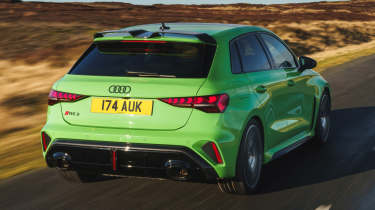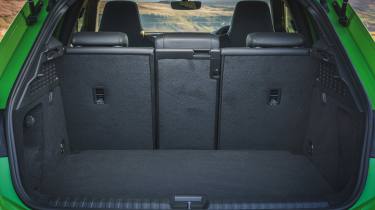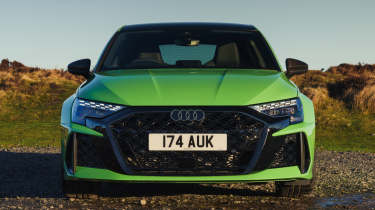Audi RS 3 review
The latest Audi RS 3 is a sensational hot hatch with a powertrain to match, but the interior could be more premium at this price point

Is the Audi RS 3 a good car?
Throw an Audi RS 3 up against a modern high-performance electric car and it’ll feel sluggish and a bit compromised, but this is to take it on face value and ignore its charm. Audi built its reputation on turbocharged five-cylinder engines, grippy all-wheel-drive systems and the ability to cover rough roads at ferocious speed. When considered against those metrics, the RS 3 remains in a class of one. It’s not slick, but the RS 3 offers things a modern EV has not yet been able to achieve: character and true engagement.
| Key specs | |
| Fuel type | Petrol |
| Body style | Five-seat saloon/hatchback |
| Powertrain(s) | 2.5-litre in-line five cylinder, turbo, |
| Safety | 5 stars |
| Warranty | 3 years/100k |
How much does the Audi RS 3 cost?
There are few everyday performance cars that do quite such a good job of channeling a brand’s heritage as the Audi RS 3. The ultra-high performance hot hatchback and compact saloon might not share their shape with the iconic Quattro in the same way as a modern Porsche 911 and its forebears, but the correlation is arguably no less distinct. Starting at just over £60,000, the RS 3 might not represent the future of Audi, but it certainly does help shape it.
There are three trim levels available in the UK, with the base Sportback costing £60,135, the Carbon Black £64,785 and the fully loaded Carbon Vorsprung £69,275. The saloon body style adds £1,000 to the price of each trim level.
Used - available now
Added equipment in the Carbon Sport includes a different set of 19-inch wheels, a rear wing, carbon-fibre mirror caps and upgraded Matrix LED headlights. The Carbon Vorsprung then throws in the proverbial kitchen sink, with adaptive dampers, a top speed increased to 174mph, a panoramic sunroof, keyless entry and start plus an upgraded active park-assist system.
Engines, performance & drive
| Model | Power | 0-62mph | Top speed |
| Audi RS 3 | 394bhp | 3.8 seconds | 155mph |
The RS 3 is one of Audi’s few models that has retained the same powertrain layout across all of its generations, which in this case is both its best and most compromised elements. Its unusual 2.5-litre five-cylinder engine is full of character, with a deep and resonant exhaust note reminiscent of those iconic Quattro rally cars from the eighties. Peak power is rated at 394bhp, and it’s generated with the help of a large single turbocharger.
Yet the forced-induction layout is quite simple and does without any clever tech, so turbo-lag is noticeable. Combined with the often sluggish dual-clutch transmission, the RS 3’s peak performance can take time to access. You need to plot your heavy throttle applications carefully, anticipate the delay and then hold on for the rush. Owners of a modern EV would be aghast at this notion, but it can be tempered.
This slow-witted response can be minimised in the most aggressive driver modes, including two RS settings that can be personalised and accessed directly from the steering wheel. It’s now that the performance isn’t just objectively fast, but feels like an event due to the evocative engine note. The RS 3’s 0-62mph time is rated at 3.8 seconds on paper – a figure that feels accurate so long as launch mode is activated – with a top speed of 155mph, or 174mph for the top-spec Carbon Vorsprung model we’re driving here.
The chassis has its own strengths, with Audi’s engineers paying close attention to a few key elements. These include widening the front track, changing the suspension geometry and fitting wider wheels and tyres to give the car more front-end grip.
In general, the suspension set-up feels quite performance biased at low speeds with a broadly firm ride, but as you speed up and put some load into the chassis, things smooth out to give it an impressively fluid and supple feel. The wheels are resistant to being thrown off by rough roads or off cambers, helped by steering that’s accurate and direct. Dampers are passive on the lower two RS 3 models, but our top-spec car swaps these for an adaptive set that helps further smooth off the ride on poor surfaces.
Traction is good, but the all-wheel-drive system does allow some slip from both front and rear axles. As a Haldex-style system, the maximum torque able to be sent to the rear wheels is only 50 per cent, but the RS 3’s trick torque-vectoring rear differential can then also send drive across the rear wheels under acceleration. When putting power down under boost you can feel it being shifted around, not unlike the feeling of a Nissan GT-R.
There’s even a mode that will have the outside rear wheel over-rotate on purpose to elicit oversteer. This was in place in the previous generation, but further calibration work has improved its consistency. As selected, it can gently coax the rear end into slip before quickly gathering it all up and firing you down the road. The RS 3 used to be something of a blunt instrument, but this generation has taken considerable steps towards offering a more engaging driving experience, something this mid-life update has only improved upon.
MPG, CO2 & running costs
| Model | Economy | C02 | Insurance group |
| Audi RS 3 | 31.0mpg | 207g/km | N/A |
Audi quotes a fuel-efficiency figure of 31.0mpg for the RS 3, with a corresponding 207g/km of C02. We found that when driven at normal pace this figure is conservative, and with a bit of motorway driving and some pottering around up to 35mpg could be possible. Long runs could even see this jump to closer to 40mpg, although it does take a very light foot to break that benchmark.
The kickback comes in towns and cities, because despite a decent stop-start system the RS 3 does get through fuel when pottering at low speeds. We also found that the dual-clutch transmission has particularly conservative mapping, meaning that it can feel quite sluggish and slow to respond. Other running costs will be higher than average, thanks to the wide, high-spec tyres and the aggressive suspension geometry run, particularly on the front axle.
The RS 3 is the only new car on sale to have a wider front rubber than rear, with a 265-section width up front and just 235-section tyres on the rear. The standard Pirelli P Zero set-up is good, but for those wanting to extract the ultimate performance from their RS 3, Audi UK now offers the option of track-focused Trofeo R rubber. When fitted, the car’s dry-road performance is lifted up to another level, but the softer compound will require replacing more often, and they’re more expensive as well. The big brakes also need to be looked after, and while the optional ceramics make short work of track days, pad replacements can be even more expensive.
Design, interior & technology
Build quality inside is fine, but many of the plastics aren’t up to the standard of typical Audis, let alone one costing the thick end of £60,000. There have been a few improvements in quality in certain areas compared with the previous version – we’re talking about small elements inside the air vents and door cards – but in general too many of the hard-finish plastics are still there and feel cheap. The standard seats are fine, but you can now opt for a much more serious set of carbon-backed buckets. Together with the new steering wheel, they give the interior a welcome lift, although the fresh touch-sensitive buttons are a backwards step.
Sat-nav, stereo and infotainment
The digital interfaces also aren’t especially fancy and fall short of modern rivals, including VW Group siblings the Volkswagen Golf and Cupra Leon. The eight-inch screen is at least fast to respond and supports painless wireless Apple CarPlay and Android Auto, and works well with the 12.3-inch digital driver’s display that’s got a good level of customisation.
The embedded navigation system is typical Audi and works very well. It’s easy to program and reliably shows traffic and tailback information. It’s also able to support full satellite views, and while the graphics in all modes look slick, we just wish the display was bigger. As with all A3 models and derivatives in this update, the previous B&O system has been replaced by SONOS, which has good sound quality and levels.
Boot space, comfort & practicality
| Dimensions Sportback (saloon) | |
| Length | 4,381mm (4,533) |
| Width | 1,984mm |
| Height | 1,430mm (1,412) |
| Number of seats | Five |
| Boot space | 282 litres (321 litres for saloon version) |
The Audi RS 3 is fundamentally no more or less practical than a standard A3 of the same generation. The rear seats are fine for two people, but three can be a squeeze across the relatively narrow body. Leg and headroom in the second row is better than its key Mercedes-AMG A-Class rival, and there’s a nicely sized armrest between the rear seats to up the comfort levels.
Boot space in the Sportback variant is a little lower than rivals, at 282 litres, but the space is square and there’s even a little bit of underfloor storage. The relatively boxy body also means that the load bay is quite versatile and the rear bench also folds in a 60/40 split. The saloon’s boot is slightly bigger, at 321 litres, but obviously is limited to a sealed bootspace through a smaller opening. The rear seats will fold, though, so longer items can be carried.
Safety & reliability
| Key standard safety features | Euro NCAP safety ratings |
|
|
Audi quotes a full five-star Euro NCAP safety rating for the A3, of which the high-performance RS 3 is merely an extension of the range. The latest 2025 regulations do mean active lane-keep and speed warning systems are in place, but despite the RS 3’s relatively old interior design, there is a dedicated switch that’ll take you to a menu to easily disable the system if you wish.
Thanks to the relatively small volume sold, there’s not much data on the car’s overall reliability. But Audi’s low ranking in terms of owner satisfaction across all its models doesn’t bode well for a premium brand. The company finished 27th out of 32 manufacturers in our 2024 Driver Power survey. The five-cylinder engine is a well known entity, so reliability issues have not been flagged. But the dual-clutch transmission has been a weak point for many Volkswagen Group cars, with clutch replacements not uncommon – especially on high-performance models such as this.
Audi RS 3 alternatives
The Mercedes-AMG A 45 S and the four-door CLA 45 S remain the RS 3’s key rivals, with similar price points and levels of performance. Both produce more power, with 416bhp, but it comes from a more highly strung four-cylinder engine that’s effective, but has less character. The chassis has a similarly fluid quality and the all-wheel-drive system has its own torque-vectoring differential, but there’s something a little less engaging about the overall driving experience.
The BMW M2 is priced slightly higher, but comes with more power, technology and prestige. Its rear-wheel-drive chassis is more entertaining, and the option of a manual transmission is a definite boon to enthusiasts. However, those looking for ultimate all-weather capability will miss the Audi’s all-wheel-drive system. Then there’s the Tesla Model 3 Performance, which is significantly quicker in a straight line but lacks any real sense of engagement.
















